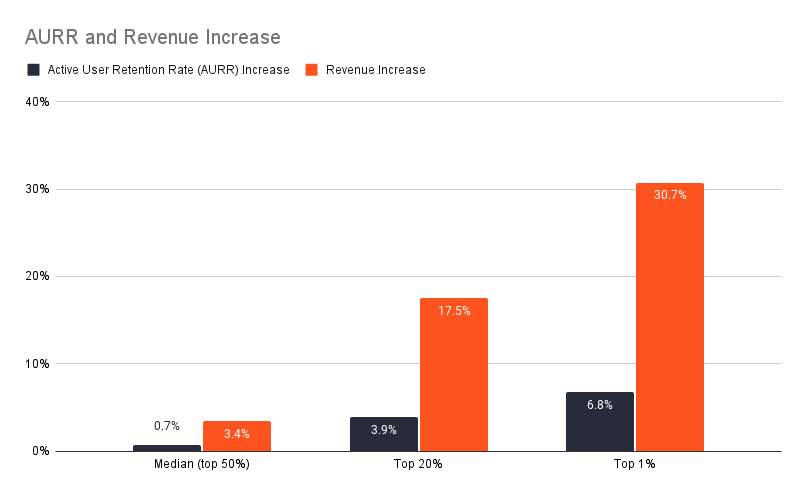How to Maximize Earnings from Every App User
If you want to increase your app's customer lifetime value (LTV), how will you do it? There are two complementary directions. The first and obvious path is to improve your product so that more customers want it and pay for it. The other road is to enhance communications outside of the product. With the right customer messaging, you can double LTV without any changes in the app itself. This strategy has worked for websites for at least 20 years. Retailers and ecommerces understand that communicating through direct marketing channels, like email, can deliver up to a 50% revenue uplift.
Let's embark on an expedition to explore how these ideas translate to mobile apps with in-app purchases and uncover any messaging nuances between iOS and Android.
Two Components of Revenue Boost
If you can't measure something, you can't improve it. Thus, we need a way to understand how our communications and messaging impact LTV.
Before diving into solutions, let's set some terms straight. While LTV typically includes a cost component, our focus here is on increasing earnings, assuming a constant acquisition cost. So, in this piece, we're using LTV to mean just the total revenue from an average customer over their lifetime.
In most cases, the communications and messaging LTV boost has two components:
Direct increase in paid conversions
Retention enhancement that leads to long-term revenue growth
If you've ever tried to start a fire in a grill or fireplace, you'd know that igniting the flame and maintaining it require different approaches. Getting the first paid conversion is like that initial spark: it demands a lot of energy, comes with high costs, and can often fall short. Meanwhile, increasing retention is akin to tending to those burning embers. It requires patience, diligence, and, just as you'd periodically check to ensure the fire stays alive, regular feedback to ensure customer interest remains steady.
Typically, you need one sophisticated message flow that does most of the job to support the ignition and get conversions. While the campaign goal can differ, the structure remains consistent across various business models. If you have a freemium app, the goal is to convert from free to paid users. For a free trial, you must ensure the customer doesn’t cancel the subscription before the trial ends. For transactional free-to-play or free-to-use, you need to prompt the first purchase.
The “keep-fire” retention campaigns primarily focus on active users. You want them to stay, use the app, and pay you for as long as possible. In practice, it makes sense to address different lifecycle stages of active users in distinct ways. For example, you can have unique campaigns for new customers, frequent users, and those who have stopped using the app. However, the ultimate goal is always to attract and retain as many active users as possible.
How Significant is the LTV Increase?
What results can you expect from ignition- and retention-focused communications? At Reteno, we analyzed the impact of marketing campaigns on tens of millions of users. Here are the results: the top 20% of our customers generate 14.7% of conversions from the ignition campaign. Please pause for a moment and consider that figure. Just one (!) messaging campaign done right can boost revenue by almost 15%. If your results are below this, there's a quick win opportunity for you.
We based the numbers presented in Chart 1 on post-click 24-hour attribution. If customers click on a push notification or email and complete a conversion within 24 hours, the results are credited to the campaign.
To gauge the impact of retention on revenue, it's crucial to be transparent about the metrics and calculations. I've detailed this in a separate essay. However, when discussing benchmarks, the findings are as follows: the top 20% of our customers see a 3.9% rise in AURR and a 17.5% increase in earnings.
A well-executed ignition and retention messaging strategy can drive revenue growth between 30% and 50%. Reteno's primary goal is to make these results achievable for both market leaders and every mobile app.
How do you get the best results?
And now, we come to the difference between the best performers and the worst examples.
The most common pitfall leading to poor results is infrequent and monotonous messages. Product teams often start with push notification tools like Firebase, asking programmers to code some basic reminders. These campaigns usually consist of only a few messages with templated texts, which quickly makes users disinterested in this repetitive communication.
Achieving optimal results usually demands several iterations. Hardcoded campaigns present challenges in management, scaling, and measurement. Reteno’s top clients achieve 30-50% LTV growth without modifying the product. They pay significant attention to ignition campaigns and typically send 3 to 5 varied messages weekly, with most being triggered by customer behavior, to retain active users.
It's worth noting that these peak results are achieved mainly through big players with a dedicated team focused on messaging and retention. Therefore, we at Reteno aim to create a tool that lets every customer, regardless of crew size, hit this performance level.




